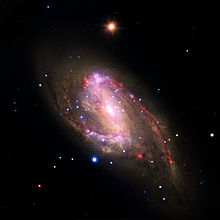Messier 66
 Galaktyka spiralna z poprzeczką Messier 66 (ESO) | |
| Odkrywca | |
|---|---|
| Data odkrycia | 1 marca 1780 |
| Dane obserwacyjne (J2000) | |
| Gwiazdozbiór | |
| Typ | spiralna z poprzeczką SAB(s)b |
| Rektascensja | 11h 20m 15s |
| Deklinacja | +12° 59′ 30″ |
| Odległość | |
| Przesunięcie ku czerwieni | 0,00234[1] |
| Jasność obserwowana | 9,7m |
| Rozmiary kątowe | 9,1' × 4,2' |
| Charakterystyka fizyczna | |
| Satelity galaktyki | |
| Alternatywne oznaczenia | |
| M66, NGC 3627, UGC 6346, PGC 34695, Arp 16 | |
Messier 66 (znana również jako M66, NGC 3627 lub Arp 16) – galaktyka spiralna z poprzeczką, znajdująca się w gwiazdozbiorze Lwa w odległości około 36 milionów lat świetlnych od Ziemi. Została odkryta 1 marca 1780 roku przez Charles’a Messiera[2].

M66 ma średnicę 96 tysięcy lat świetlnych. Wzdłuż rozległych spiralnych ramion galaktyki znajdują się ogromne ilości pyłu i liczne jasne gromady gwiazd. M66 wraz z galaktykami M65 i NGC 3628 jest częścią małej grupy galaktyk Triplet Lwa.
W galaktyce tej zaobserwowano dotychczas cztery supernowe: SN 1973R, SN 1989B, SN 1997bs (prawdopodobnie tzw. fałszywa supernowa) i SN 2009hd[3].
Zobacz też
- Katalog Messiera
- Triplet Lwa
Przypisy
- ↑ Messier 66 w bazie SIMBAD (ang.)
- ↑ Courtney Seligman: NGC 3627 (ang.). Celestial Atlas. [dostęp 2015-02-01].
- ↑ List of Supernovae (ang.). W: IAU Central Bureau for Astronomical Telegrams [on-line]. Międzynarodowa Unia Astronomiczna. [dostęp 2015-02-01].
Linki zewnętrzne
- Messier 66 w serwisie APOD: Astronomiczne zdjęcie dnia
- Messier 66 w bazie SEDS (ang.)
- Triplet Lwa w bazie SEDS (ang.)
- Messier 66 w bazie SIMBAD (ang.)
- Messier 66 w NASA/IPAC Extragalactic Database (ang.)
Media użyte na tej stronie
Autor: ESO, Licencja: CC BY 4.0
Colour composite image of the spiral galaxy M 66 (or NGC 3627) obtained with the FORS1 and FORS2 multi-mode instruments (at VLT MELIPAL and YEPUN, respectively). NGC 3627 is located in the constellation Leo (The Lion). It is a beautiful spiral with a well-developed central bulge. It also displays large-scale dust lanes. Many regions of warm hydrogen gas are seen throughout the disc of this galaxy. The latter regions are being ionised by radiation from clusters of newborn stars. North towards upper left, West towards upper right.
ID: phot-33c-03-fullres
Size: 2300x2294
Credit: ESORevealing Hidden Black Holes
The spiral galaxy NGC 3627 is located about 30 million light years from Earth. This composite image includes X-ray data from NASA's Chandra X-ray Observatory (blue), infrared data from the Spitzer Space Telescope (red), and optical data from the Hubble Space Telescope and the Very Large Telescope (yellow). The inset shows the central region, which contains a bright X-ray source that is likely powered by material falling onto a supermassive black hole.
A search using archival data from previous Chandra observations of a sample of 62 nearby galaxies has shown that 37 of the galaxies, including NGC 3627, contain X-ray sources in their centers. Most of these sources are likely powered by central supermassive black holes. The survey, which also used data from the Spitzer Infrared Nearby Galaxy Survey, found that seven of the 37 sources are new supermassive black hole candidates.
Confirming previous Chandra results, this study finds the fraction of galaxies found to be hosting supermassive black holes is much higher than found with optical searches. This shows the ability of X-ray observations to find black holes in galaxies where relatively low-level black hole activity has either been hidden by obscuring material or washed out by the bright optical light of the galaxy.
The combined X-ray and infrared data suggest that the nuclear activity in a galaxy is not necessarily related to the amount of star-formation in the galaxy, contrary to some early claims. In contrast, these new results suggest that the mass of the supermassive black hole and the rate at which the black hole accretes matter are both greater for galaxies with greater total masses.
A paper describing these results was published in the April 10, 2011 issue of The Astrophysical Journal. The authors are Catherine Grier and Smita Mathur of The Ohio State University in Columbus, OH; Himel GHosh of CNRS/CEA-Saclay in Guf-sur-Yvette, France and Laura Ferrarese from Herzberg Institute of Astrophysics in Victoria, Canada.
NASA's Marshall Space Flight Center in Huntsville, Ala., manages the Chandra program for NASA's Science Mission Directorate in Washington. The Smithsonian Astrophysical Observatory controls Chandra's science and flight operations from Cambridge, Mass. About the Object
Credit
NASA/CXC/Ohio State Univ./C.Grier et al.; Optical: NASA/STScI, ESO/WFI; Infrared: NASA/JPL-Caltech
Name
NGC 3627
Type
Galaxy > Type > Spiral Galaxy > Component > Central Black Hole
Distance
29,000,000 Light Years
Color Mapping Band Wavelength Telescope X-ray 1.5 keV Chandra ACIS Optical 429 nm VLT WFI Optical 554 nm VLT WFI Optical 657 nm VLT WFI Optical 814 nm Hubble WFPC2 Optical 658 nm Hubble WFPC2 Optical 555 nm Hubble WFPC2 Optical 814 nm Hubble ACS/WFC Optical 555 nm Hubble ACS/WFC
Infrared 4.5 µm Spitzer IRAC
